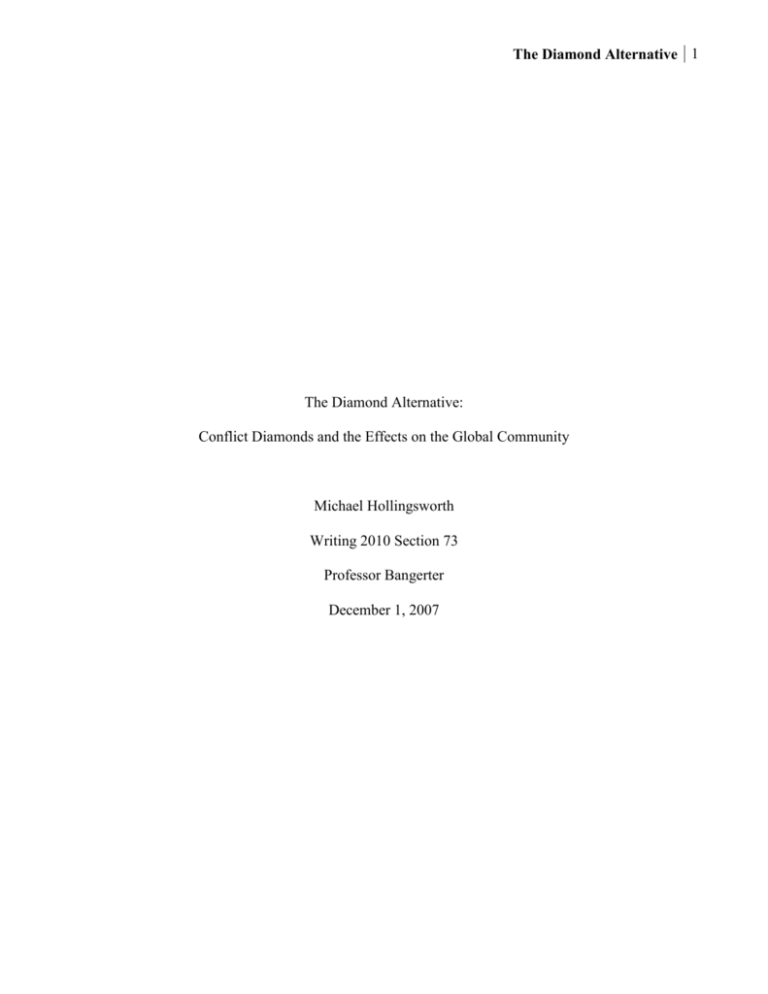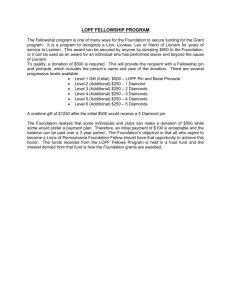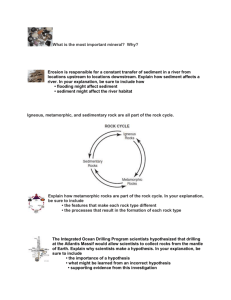The Diamond Alternative
advertisement

The Diamond Alternative 1 The Diamond Alternative: Conflict Diamonds and the Effects on the Global Community Michael Hollingsworth Writing 2010 Section 73 Professor Bangerter December 1, 2007 The Diamond Alternative 2 The Diamond Alternative: Conflict Diamonds and the Effects on the Global Community The diamond is the symbol of love for the modern age of the world, but is the dark side of this lustrous gem seen? One of the objects of every girl’s dreams is her engagement ring, how it will look, what will the band be like, will it be yellow gold, white gold, or platinum? These are important aspects of the ring but the most crucial characteristic of the ring is the diamond, the carat, color, clarity, cut and how many there will be in this ring of such sentimentality. The sentimentality of the ring does not atone for the sins that were committed in mining millions of these gems. The individual purchaser should not be held as the one at fault for the extortion that happens at the hands of the miners and the groups running the mines. The individual purchaser is not a fault for the actual processing of the diamond, yet, rearing its ugly head to be seen by those who look for it, is the dragon of diamond mining. In this lies the fault of the common consumer: the ignorance of the pain and suffering that went into the mining of the most-desired stone on earth. As with every natural resource there are some areas of the planet that are more blessed with diamonds, but every individual country is part of a symbiotic-global community in relation to the economy, ethics, technology, and human life. Found intertwined in the symbiosis are aspects of parasitic relations as well. Just as a small stone that is knocked loose and falls can cause an avalanche, a small gem that is found in the hands of a corrupt few can cause such devastation that entire countries, economies, and most importantly, human life and wellbeing are destroyed. That which affects one area, region or country will affect all others. The global The Diamond Alternative 3 community has the responsibility to correct the problem created by the lust of diamonds. The cure to this disease is man-made diamonds. Conflict Commodities and Conflict Diamonds The disease is the trade of what are known as conflict diamonds. Conflict Diamonds are gems that are mined in war-torn countries to fund the mine “owner’s” beliefs or bids for power. They are used to perpetuate war in a country by selling the diamonds to diamond manufacturers where the diamonds are then sold to jewelers that sell to the general public (Global Witness, 2006). “So-called ‘conflict commodities’ have financed, to a large degree, about a third of armed conflicts since the end of the Cold War” (Le Billon, 2006). Conflict commodities can come in such a wide range of products and resources that any resource can become a conflict commodity. The timber and rubies from Cambodia were used to fund the Khmer Rouge. Oil from other countries around the world can be used for the funding of terrorist and rebel groups. Diamonds come from the different reaches of Africa and India. The range of what a conflict commodity can be is so vast that it can be quite impossible to know if we are in fact contributing to the suffering of others for the benefit of our own comfort (Le Billon, 2006). The reality of conflict diamonds, or blood diamonds as they are also known, is one of the tragedies of the modern age. The uncouth occurrences of the diamond trade are finally coming to light after the loss of many hundreds of thousands of lives. But, this loss does not only limit itself to the loss of life. The loss includes the loss of liberty, the pursuit of happiness, limb, displacement and many other effects. Some of the effects are not only things being taken away from the victims, but also can be things added to the victims such as emotional and mental scarring. The Kimberley Process The Diamond Alternative 4 As a feeble attempt to end this problem, several countries being led by the United States met together to create what is known as the Kimberley Process. With South Africa, Britain, Belgium, major diamond-producing countries, groups such as Global Witness, and companies like De Beers came together for a conference to discuss the demise of the diamond problem. The Kimberley Process is very important first step for finding a solution for conflict diamonds. Just the fact that the agencies, companies and countries are meeting demonstrates the attention in the world view that the cause of conflict-free diamonds is raising in the world today. There are three main points to the Kimberley Process: 1. All participating countries agreed to trade only rough diamonds and to establish national export-import control regimes to keep illicit diamonds from the legitimate diamond trade (Ndumbe & Cole, 2005). 2. Diamond-producing and –trading countries must certify that all their rough stones are conflict free. The certification system relies on participants implementing an effective control system to preclude trading in conflict diamonds (Ndumbe & Cole, 2005). 3. The process defines conflict diamonds as rough diamonds used by rebel armies or their allies to fund wars and to undermine legitimate governments as defined by the UN General Assembly Resolution 55/56 (Ndumbe & Cole, 2005). The process is an excellent first attempt but is still found lacking. The Kimberley Process was found lacking in the fact that the industry received “the power to regulate itself” in 2003 (Ndumbe & Cole, 2005). The history of the diamond industry is such that this could not be done because of the manner in which the industry had supported itself in the early twentieth century. This support came at a terrible price filled with atrocities. The Diamond Alternative 5 China and Diamond Manufacturing To understand the gruesome truths of the diamond mining, one must understand the danger that may come to pass in the world market with new companies trying to break into the diamond industry. De Beers, the lead diamond company in the world, has made a statement that there may be a shortage of diamonds in the rough in the next few years. Diamonds are a $31 billion-a-year retail market in the United States alone. The United States also accounts for about a half of the world market. De Beers is also spending $200 million dollars on marketing alone and is losing money to companies like Tiffany, as well as to companies like Wal-Mart and online companies (Kandell, 2007). In China, the Shanghai Diamond Exchange is beginning to have a real increase in sales. Posnock, a writer in the National Jeweler, has written of cars manufactured in Japan. When the United States was going through the oil crisis of the 1970s, the gas prices were very high. During this crisis, Japan came out with “smaller, more fuel-efficient models [that] eventually gained acceptance” (2007). These small Japanese cars initially were met with resistance in the United States market. Now, Japanese cars are being met with open arms here in the United States. In the same way, Chinese diamonds and jewelry is being met with resistance but it is beginning to progress quite rapidly. China is manufacturing diamonds for less and is passing on the savings to the consumer. The lower prices allow the consumer to buy more diamonds for the same amount of money that they were before from the other jewelers and manufacturers (Psonock, 2007). This will cause an increase in demand, causing the diamonds-in-the-rough supply to dwindle. The dwindling numbers will cause the prices to go up, hurting the average consumer, as well as the economies that are reliant upon the diamonds. These countries that represent the economies will become more desperate and more violent. The Diamond Alternative 6 Alluvial and Kimberlite Mining To understand the anarchy and violence that takes place at the diamond mines, one must understand the different methods of mining. Diamonds are formed in kimberlite pipes that can reach kilometers down into the earth. As streams and rivers run, they can erode away the crust of the earth and enter into the kimberlite pipes causing diamonds to break loose and flow down with the streams. The Alluvial mining process involves scooping the silt from a river bed and sifting through it to find the diamonds. This process is very similar to panning for gold. Alluvial mining may also include damming and changing the course of a river to expose the river bed to the miners. Alluvial mining is arduous work with the need for large amounts of manpower. This style of mining is mostly used in countries like Angola, the Democratic Republic of Congo, Sierra Leone and other West African countries. Alluvial mines are usually surrounded by jungle where it is easy for rebels to hide, making them a prime location for these groups (Olsson, 2006). Kimberlite mining is comparable to oil drilling. With the use of high-tech machinery, a drill is set up to bring the diamonds to the surface. In Namibia, it is done off shore in the Atlantic Ocean. In other countries like Botswana, it is done in the deserts, in Canada and Russia, the mining is done in arctic areas. This process is also used in South Africa and Australia. The mining is very capital intensive because of the high-tech machinery, however, it is much easier to protect with fencing or by being in the ocean or arctic regions. This helps to keep people from trying to commandeer the mines (Olsson, 2006). African Nations and the Conflict Diamonds are found in a number of African nations. Some of these nations are violent and have social tension, while others do not. There are some countries that have become very The Diamond Alternative 7 successful, even though they have major industry in diamond mining. Some of the countries that are successful are Botswana and Namibia. There are two factors that can be attributed into making these two countries successful: “the strength of institutions of private property as well as the nature of the extraction process” (Olsson, 2006). These countries use kimberlite mining instead of alluvial mining. There are many factors that go into a country going violent and unstable. There is what Olsson (2006), from the Göteborg University, calls the ‘Dutch disease.’ The Dutch disease is “an appreciation of the local currency and a subsequent crowding-out of manufacturing sectors” (Olsson, 2006). Another factor could be the dependence of the natural resources of a specific area or country and “the poor human capital accumulation, rent seeking, the emergence of weak institutions of private property, or even civil war” (Olsson, 2006). Yet, the dependence on natural resources does not always lead to civil war or other negative outcomes. The United States has always had large quantities of natural resources. While the United States was growing and new discoveries were being made about how great the abundance of natural resources is here, the European nations were struggling because of overcrowding. In England, there was the need to recycle gravesites because there was just not anymore space to bury anyone else. Once the colonial period began, the people began to come to the colonies to settle and have the freedom of choice that this new land offered. This freedom is an amazing feat when viewed with the abundant natural resources that there are in the United States. These resources included timber, which was a conflict commodity in Cambodia that funded the Khmer Rouge, gold, iron, and other minerals, and land for farming and homesteading (Le Billon, 2006). The Americas have also been a land of bloodshed. After Christopher Columbus came to the Americas, many other explorers followed him. One of those explorers that followed The Diamond Alternative 8 Columbus was Hernán Cortés. Cortés described the riches to the king and queen of Spain that were here. The wealth of the Aztecs was plundered for the countries of Europe, in particular Spain, the Aztec culture was swallowed up into the culture of the Spaniards. Because of the riches of the Mayan and Aztec and other indigenous nations of America, these people became enslaved and killed until these once proud nations have only small remnants and ruins of what once was. These examples show how the world has been affected by natural resources and how people react. Not all countries have reacted in a negative way but many have, such is the case with Africa. Each one of the countries that are affected by conflict diamonds have related yet distinct histories. In Angola, the civil wars embarked while it was still a colony of Portugal. There were two different factions; one was being supported by the Soviet Union and Cuba, while the other was supported by the United States and Angola’s African neighbors. As Portugal gave Angola its independence, there was a political-power vacuum left for the strongest bidder. As the USSR collapsed, the support was taken away from the Marxist faction, causing a need for a source of monies to supply the war effort. Raiding the diamond mines was the solution that seemed the most apparent. The mining continued until there was a sanction placed upon their diamonds in attempts to stop the distributing of conflict diamonds. Angola then began to spread the diamonds through the world by smuggling them through the borders to the neighboring Democratic Republic of the Congo and Zambia. De Beers was also involved with illegal transactions for conflict diamonds in Angola at the same time (Ndumbe & Cole, 2005; Olsson, 2006). The Democratic Republic of Congo (DRC) has a similar story. Of all the diamonds produced in the DRC, approximately 75% were smuggled before the year 2000. “For example, The Diamond Alternative 9 in 1999 official [legal ]exports were valued at $261,361,308 as compared to an estimated $490,613,333 of smuggled” (Ndumbe & Cole, 2005). Liberia is also one of the countries that have the sad history of being tainted by conflict diamonds. In the 1950s, Liberia’s president wanted to bring all of western Africa under one rule and banner. Thus, the president tried to begin with Sierra Leone and to plunder the mines there and use them to fund his war to expand his borders. In addition to just wanting to plunder from the supply of the diamonds from other countries, Liberia had smuggled many diamonds out of their country. From 1994 to 1998 the reported production capacity was between 100,000 and 150,000 carats. “Paradoxically, records of the Hoge Raad Voor Diamant in Antwerp, Belgium, during the same period showed that [Angola] had exported more than 31 million carats of diamonds to Belgium, with an average of more than 6 million carats” (Ndumbe & Cole, 2005). The discrepancy shows how easy it is for the conflict diamonds to be moved about though other countries and to be sold on the world market. Perhaps one of the saddest accounts is that of Sierra Leone. Sierra Leone is abundantly wealthy in the natural resources of diamonds. Even in the 1937 the diamond production in this small country was one million carats in diamonds. The production was doubled by 1970. As Prime Minister Siaka Stevens took office, “he quickly turned diamonds and Sierra Leone Selection Trust (SLCT) into a political problem, tacitly encouraging illegal mining” (Ndumbe & Cole, 2005). Stevens and his success other perpetuated the problem of conflict diamonds by further organizations that they formed. The atrocities at the mines themselves are heinous. There is murder, beating, rape, and many other crimes that are committed. One account is of a father and son as given to De Sam Lazaro, a reporter for PBS: The Diamond Alternative 10 The father states, “First used the ax to chop the left hand off. After, they want to cut the other, then this little boy started crying and said, ‘Please soldier, don’t cut off my papa’s other hand.’ So they said, ‘Let this woman remove this child from her back, we’ll chop off his arm.’ And I said ‘No!’ So they decided to hop the other hand off.” De Sam Lazaro then remarks, ‘So they basically said you could have your right hand if you gave your son’s hand.’ The father responds ‘Yes’” (Global Witness, 2006). This is just one example of many stories like this in the world today from the conflicts caused by the lust for diamonds. Another sad fact of Sierra Leone is the condition of the educational system. Sierra Leone allocates a high amount of their budget to their military with some meager leftovers for the other branches of society, including the school system. The school system funding itself is skewed. Practically all the funding goes to higher education with a small amount of funding for the primary and secondary schools. The equilibrium is off in the fact that the funding is 50% for the universities with an extra 30% reserved for the teacher colleges and a derisory 20% left for the primary and secondary schooling. This creates an enormous lack of funding for the younger children as well as children from the poorer families and the families that do not live in the big urban centers. “Calculations based on data obtained from the Ministry of Education for the period 1987-1988 show the percentage of boys in the 5-11 age group attending school to be 90.2% in 1988, and girls to be only 60.9%. The disparity increased for the 11-16-year-old group, with less than one in three girls, as opposed to the more than one in two boys in school” (Banya, 1993). The societal role of women in Sierra Leone is to be involved only in the bearing and caring for children. There is no push for women to become educated and advance themselves. “Women are still expected to leave school early to be married and raise a family” (Banya, 1993). The Diamond Alternative 11 The quality of the education in Sierra Leone is discouraging as well. “Living conditions have declined remarkably for students and class sizes have doubled without a corresponding increase in resources to run the university. The lack of resources for research and professional growth… have all contributed to the decline in the quality of university education” (Banya, 1993). “At the secondary school level, criticism has focused on the irrelevance of the content of curricula and on antiquated teaching methods” (Banya, 1993). By these observations, it would show that the government is trying to supply mine workers by only giving them the option of working in the mines because of the lack of education. Sierra Leonean government is trying to appear that they are supporting their education system by having the high funding for the colleges but it is on a superficial claim. The rich and the elite are the only people that are getting a quality education. This lack of education can be compared to the slavery of the South of the United States before the Civil War by the fact that the slaves were not allowed to read or write or receive any education. This was to make the slaves remain uneducated and unwilling to fight for the rights that they have as human beings. The slaves were eventually freed by the North and, over time, they are becoming equals in the world. Now there is a solution that can give these people of Sierra Leone that chance of being equal with every other person in the world. The New Alternative of Man-Made Diamonds The equality will come through the world community becoming more educated. Learning and technology are rapidly advancing in an alarming rate. As technology advances there are new methods in the man-made production of diamonds. The possibilities for these new diamonds are not only limited to jewelry but also are related to technology intensive fields as well. The Diamond Alternative 12 There are computers that can help bring peace to the people of the world through the ability to understand more. Instead of using a silicon base for the boards of the computers, the boards will be made of an actual diamond. These will cause the technology to leap ahead as this new type of computer becomes available. These new methods also make it possible to create diamonds of gem quality, with the same carat, color, cut, and clarity of their natural counterparts. Here in the United States, there are companies that have the ability to create diamonds quickly and safely, without the loss of human life that accompanies the alluvial mining in the war-torn countries of Africa and the world. Gemesis, a man-made diamond manufacturing company, can make a 2.8 carat yellow diamond in only three-and-a-half days. This diamond is identical to the natural, even to the trained gemologist and is 30% less than the cost of a rare diamond such as the one of this example (Yarnell, 2004). In addition to all of these benefits, there are more. For that young couple who are just starting out on life’s winding roads together, there are more options. That one time ring that would have been impossible to afford for the young fiancée is now available due to the lower costs of man-made diamonds. This is not the main reason to follow such new technology that claims much about what it can do now, but also has a bright and promising future. The main reason and motivation for this technology should be the sanctity of human life, the countless hoards of people that would be saved from the mines of Africa. That, with this technology, could work for a better future in their countries, the future of gaining an education and reinvesting what they have gained into what could be a peaceful Africa and world. Conclusion The Diamond Alternative 13 The atrocities of the past need not cloud the future with an unbearable fog. We cannot correct the wrongs of the past, we can only learn from them. The availability of the new technology has made it possible to stop the groups from using conflict diamonds and still satisfy our lust for them. We can create a new foundation to help the countries that have been hurt and destroyed by diamonds to rebuild them. As a person has a genuine desire inherited desire to do what is right, the people who are not twisted by the greed for power and dominion will see the need to use the new technology that is now becoming more readily available. The world now has the ability to help the countries that have been plagued by diamonds for generations, to give them a new hope. We can all be part of this hope. We are a crucial part of the hope that will save Africa and the world from destruction by our own lust for diamonds and the lust of power of others. The Diamond Alternative 14 References Banya, K. (1993, January 1). Illiteracy, Colonial Legacy and Education: The Case of Modern Sierra Leone. Retrieved October 27, 2007, from ERIC Database: http://search.ebscohost.com.tproxy01.kib.utah.edu/login.aspx?direct=true&db=eric&AN=EJ469461&sit ne=ehost-live Global Witness. (2006, November). The Truth About Diamonds. Retrieved October 28, 2007, from Global Witness: http://www.globalwitness.org/data/files/media_library/7/en/the_truth_about_diamonds.pdf Kandell, J. (2007, August). King of Diamonds. Retrieved October 29, 2007, from Business Source Premier: http://search.ebscohost.com.tproxy01.lib.utah.edu/login.aspx?direct=true&db=buh&AN=26367319&sit e=bsi-live Le Billon, P. (2006). Fatal Transactions: Conflict Diamonds and the (Anti)Terrorist Consumer. Retrieved October 23, 2007, from Antipode: http://search.ebscohost.com.tproxy01.lib.utah.edu/login.aspx?direct=true&db=rlg&AN=21808694&site =ehost-live Ndumbe, J. A., & Cole, B. (2005, Spring). The Illicit Diamond Trade, Civil Conflicts, and Terrorism in Africa. Retrieved November 1, 2007, from Academic Search Premier: http://search.ebscohost.com.tproxy01.lib.utah.edu/login.aspx?direct=true&db=aph&AN=17189465&sit e=ehost-live Olsson, O. (2006, August). Diamonds Are a Reble's Best Friend. Retrieved October 23, 2007, from Business Source Premier database: http://search.ebscohost.com.tproxy01.lib.utah.edu/login.aspx?direct=true&db=buh&AN=21540516&sit e=ehost-live The Diamond Alternative 15 Psonock, S. T. (2007, September). The new SILK ROAD. Retrieved October 25, 2007, from Business Source Premier: http://search.ebscohost.com.tproxy01.lib.utah.edu/login.aspx?direct=true&db=buh&AN=26629013&sit e=bsi-live Yarnell, A. (2004, February 2). The Many Facets of Man-Made Diamonds. Retrieved October 23, 2007, from C&EN Washington: http://pubs.acs.org/email/cen/html/102707125839.html




